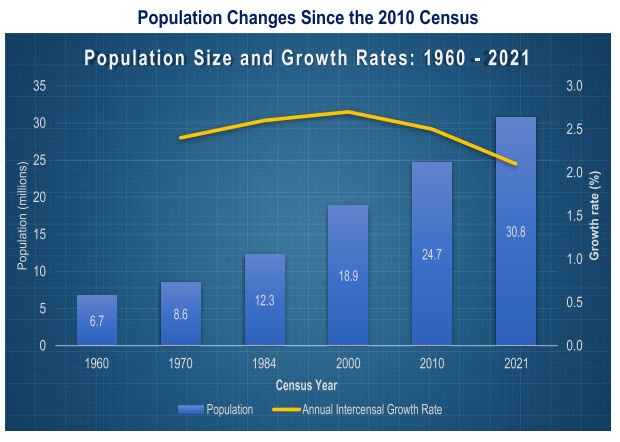- Women more than half of population
- Greater Accra overtakes Ashanti as most populous region
- Quarter of housing structures make-shift
Provisional data released by the Ghana Statistical Service (GSS) have revealed that the total number of people residing in the country as of June 27, 2021 is 30.8 million, with females, once again outnumbering males, but at a close margin.
According to the report, for the 30,792,608 people living in the country, 15,610,149 are female while 15,182,459 are male – indicating the former makes up 50.7 percent of the population. This means that the sex ratio is now 97 males for 100 females, a slight increase over the sex ratio of 95:100 recorded in the 2010 census. The 1960 census is the only post-independence census that recorded more males than females (102 males to 100 females). Since then, sex ratios have declined until the uptick observed in 2021.
With the current figure, it means the population has increased by 6.1 million from the 24.7 million recorded in 2010 – constituting an annual intercensal growth rate of 2.1 percent, less than what was observed in the previous intercensal period (2000 – 2010: 2.5 percent) and the lowest since independence. At this rate, states the report, the country ‘s population will double within 33 years. And by 2050, the population of Ghana will be over 50 million.
Regional breakdown
In terms of regions, Greater Accra is now the most populous region in the country, recording a population of 5,446,237 and overtaking the Ashanti Region which has been the most populous region since 1970, currently hosting 5,432,485 people. The two regions are both almost twice (1.9) the size of third most-populous Eastern Region, which is host to 2,917,039 people.
The Central Region is now the fourth most-populous region with 2.85 million people following division of the former Western, Brong Ahafo and Northern Regions which were all more populous than Central Region in 2010. The four most populous regions make up over half (54 percent) of the country’s total population.
The Ahafo Region is now the least populous region with a population of 564,536, taking the place of Upper West Region which had been the least populous in all the previous post-independence censuses. The Savannah and North East Regions are the second- and third-least populous regions respectively
Again, the report shows the current Northern Region observed the largest change in population with an almost 50 percent increase over its population in 2010. The two other regions that made up the then Northern Region in 2010 – North East and Savannah – had the second and third-largest intercensal increases (41.7 percent and 38.4 percent) respectively.
The next highest change recorded was in Greater Accra with an addition of 35.8 percent. The Eastern Region, followed by the Volta Region, recorded the lowest intercensal change, adding 10.8 percent and 11.4 percent respectively to their populations.
Housing
Another unfortunate detail in the report is the increasing number of makeshift structures – metal containers, kiosks and wooden shacks. Out of the 10.7 million structures listed, 20 percent were made of these structures – heightening concerns about lack of decent accommodation for many.
The information on structure usage indicated six out of every 10 structures were for residential use. Greater Accra Region recorded the highest number of both residential and non-residential structures with 19.3 percent of all the total structures listed.
The number of structures in Greater Accra is greater than the number of structures in six other regions (North East, Savannah, Ahafo, Upper West, Oti, Upper East) combined. Three regions (Greater Accra, Ashanti, Eastern) combined have almost half (47.3 percent) of all structures listed.
The region with the highest population density is Greater Accra with 1,236 persons per square kilometre, which is significantly higher than is observed in regions. This figure is over 5.5 times the density observed in Ashanti, the region with the second highest density, and almost 100 times more than Savannah Region which has 14 persons per square kilometre.










